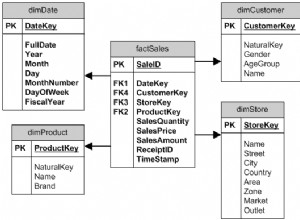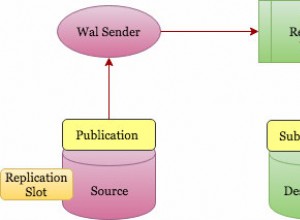ACTUALIZACIÓN:
Además del nuevo comentario a continuación:
(
SELECT t.*, COUNT(*) AS tagcount
FROM tagged td
LEFT JOIN tags t ON (t.id = td.tag_id)
GROUP BY td.tag_id
ORDER BY tagcount DESC, t.title ASC
LIMIT 3
) ORDER BY title ASC;
Resultado:
+------+------------+----------+
| id | title | tagcount |
+------+------------+----------+
| 3 | javascript | 2 |
| 1 | mysql | 2 |
| 2 | php | 3 |
+------+------------+----------+
3 rows in set (0.00 sec)
Simplemente cambie el LIMIT 3 a LIMIT 10 para obtener los 10 primeros en lugar de los 3 primeros.
Respuesta anterior:
¿Por qué no agregas un LIMIT 10? a su consulta?
SELECT t.*, COUNT(*) AS tagcount
FROM tagged td
LEFT JOIN tags t ON (t.id = td.tag_id)
GROUP BY td.tag_id
ORDER BY tagcount DESC, t.title ASC
LIMIT 10;
Caso de prueba:
CREATE TABLE tags (id int, title varchar(20));
CREATE TABLE tagged (tag_id int, post_id int);
INSERT INTO tags VALUES (1, 'mysql');
INSERT INTO tags VALUES (2, 'php');
INSERT INTO tags VALUES (3, 'javascript');
INSERT INTO tags VALUES (4, 'c');
INSERT INTO tagged VALUES (1, 1);
INSERT INTO tagged VALUES (2, 1);
INSERT INTO tagged VALUES (1, 2);
INSERT INTO tagged VALUES (2, 2);
INSERT INTO tagged VALUES (3, 3);
INSERT INTO tagged VALUES (2, 4);
INSERT INTO tagged VALUES (3, 4);
INSERT INTO tagged VALUES (4, 5);
Resultado (usando LIMIT 3 ):
+------+------------+----------+
| id | title | tagcount |
+------+------------+----------+
| 2 | php | 3 |
| 3 | javascript | 2 |
| 1 | mysql | 2 |
+------+------------+----------+
3 rows in set (0.00 sec)
Observe cómo [c] la etiqueta cayó de los 3 primeros resultados, y las filas se ordenan alfabéticamente en caso de empate.




